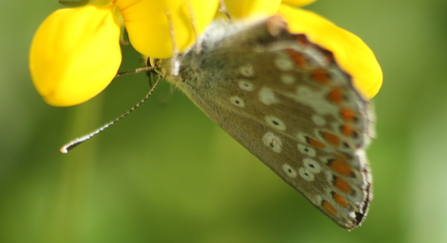Trees affected by ash dieback © Barnaby Wylder, Forestry Commission
Work starts to manage ash trees struck by deadly disease in Westmorland Dales
We're carrying out major management of woodlands at Smardale Nature Reserve near Kirkby Stephen in response to ash dieback, a disease of ash trees which is now widespread throughout the UK. Affected trees will be felled or pollarded, to make it safe.
Smardale Nature Reserve will be closed from the Smardale end from Monday 23 October 2023. The nature reserve is still accessible from the Newbiggin end, but the viaduct is still closed.
Directions to the Newbiggin-on-Lune parking area:
Grid reference: NY 703 053
what3words ///snowy.textiles.umbrella
We'll remove ash trees that are unsafe or pose a risk to public safety, because of their proximity to public footpaths. The work will take place in two phases: between October and November 2023 and January and February 2024, with a one month break over December. We advise visitors to check our website before visiting Smardale Nature Reserve during this period.
The cost of this tree safety work is expected to be around £60,000. We'll use some of the timber to offset a proportion of these costs. We'll leave other felled trees, to create valuable habitat for wildlife.
Andrew Walter, Reserves Officer at Cumbria Wildlife Trust said:
“The loss of large numbers of ash trees from Smardale Nature Reserve is a real shame, but it will give us the chance to restructure these wonderful woodlands and encourage other species to grow. When the railway was open, the track sides were kept clear of trees. However some of these areas of the nature reserve have had little management since the closure of the railway in 1960! If the trees aren’t near footpaths or the main track, we’ll leave them alone. This will give the best chance for ash seedlings that may be resistant to ash dieback to grow, and any trees with resistance to live on."
"Other trees will become standing deadwood, which is a wonderful resource for wildlife and fuels woodland ecosystems. Up to 40% of woodland species depend on deadwood at some stage of their life, including many birds, mammals, fungi, plants and insects.”
According to Andrew, there is some cause for optimism:
“The loss of ash from Smardale and our other nature reserves will be devastating, but other wildlife will benefit. Ground flora will be given a boost, until the canopy closes over again. Other tree species will take advantage of the canopy gaps and in some cases the woodland age structure could become more varied, which is great for wildlife."
“We hope that some natural resistant regeneration of the ash will be possible too. We’ll keep an eye on those trees that appear to show resistance. Once we identify these disease-tolerant trees and look after them, we should be able to restock woodlands and the wider landscape with ash.”
Smardale Nature Reserve © Cumbria Wildlife Trust
During further phases later this year or early next year, the nature reserve may be closed for brief periods. This is to ensure public safety, as some of the maintenance will involve large machinery being on site, to remove timber. Access will remain open from Newbiggin-on-Lune to the viaduct throughout the period.
There are signs at Smardale Nature Reserve to advise visitors about ash dieback management. Please check our webpage for up-to-date information about access and potential closures. In most cases, there will be an alternative way to visit the nature reserve.
Smardale is one of our most popular sites, made up of three separate nature reserves. Together, they occupy an eight kilometre section of disused railway line that once ran from Tebay to Darlington. The nature reserve stretches from Newbiggin-on-Lune almost as far as Kirkby Stephen. Famed for its viaduct, Smardale is also home to red squirrels and the rare northern brown argus and Scotch argus butterfly.
There's been woodland at Smardale since medieval times and as a result, there's a huge range of plant species. In spring there are bluebells, primroses, wild garlic and a variety of fern species on the woodland floor. Many of the trees are multi-stemmed – that’s evidence that coppicing has occurred here in the past. You can also see charcoal pitsteads in the woodland and surrounding area.

Northern brown argus © Tom Hibbert
